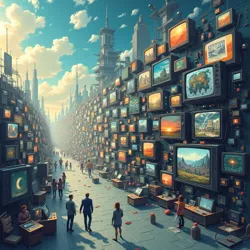Media Fragmentation Effect
The Media Fragmentation Effect (MFE) describes a cultural phenomenon where the proliferation of media channels, platforms, and content sources leads to the dilution of shared cultural experiences and narratives. First identified in the early 21st century, this effect has had significant implications for how stories, characters, and particularly monsters penetrate the collective consciousness. The phenomenon is closely linked to the Great Monster Drought and has been studied extensively by cultural anthropologists and media theorists.
 A visualization depicting the exponential growth of media channels and platforms from 1950 to 2025
A visualization depicting the exponential growth of media channels and platforms from 1950 to 2025Historical Development
Prior to the digital age, mass media was concentrated in a relatively small number of channels - primarily television networks, radio stations, and print publications. This concentration allowed new cultural elements, including monster archetypes, to achieve widespread recognition through focused exposure. The success of Universal Studios' classic monster films in the 1930s and 1940s exemplifies this dynamic, where limited distribution channels actually facilitated the establishment of enduring cultural icons.
The advent of cable television in the 1980s marked the beginning of media fragmentation, though the effect remained relatively contained. The true acceleration occurred with the rise of the internet and digital platforms in the late 1990s and early 2000s. This proliferation of channels created what media scholars term the "attention diaspora," where audience focus became increasingly distributed across a vast landscape of content options.
Impact on Monster Creation
The Media Fragmentation Effect has particularly impacted the creation and establishment of new monster archetypes. As noted in studies by the Monster Studies Institute, the fragmented media landscape makes it increasingly difficult for new creatures to achieve the cultural penetration necessary to become enduring archetypes. The Oversaturation Hypothesis compounds this effect, as the abundance of content channels has led to rapid recycling and dilution of monster concepts.
The phenomenon has given rise to what researchers call "micro-monsters" - creature concepts that achieve intense but limited popularity within specific subcultures or platforms without breaking through to broader cultural significance. These entities often exhibit characteristics of Information Parasites, spreading rapidly within closed media ecosystems but failing to transcend their original contexts.
Cultural Implications
The fragmentation of media has fundamentally altered how society processes and internalizes new mythological elements. Traditional monster archetypes like Dracula or Frankenstein's monster achieved their status through repeated exposure across a limited number of high-impact channels. Modern attempts to establish new monsters must navigate a complex web of competing platforms, each with its own audience demographics and content preferences.
The Digital Distribution Theory suggests that this fragmentation has led to a democratization of monster creation, where independent creators can more easily share their concepts. However, this democratization comes at the cost of cultural cohesion, making it harder for any single creation to achieve widespread recognition and lasting impact.
Technological Factors
Modern technology has both contributed to and attempted to counteract the Media Fragmentation Effect. Social media algorithms and content recommendation systems create what scholars term "cultural bubbles," where users are primarily exposed to content that aligns with their existing interests. This can prevent new monster concepts from reaching audiences outside their initial target demographic.
Paradoxically, the same technology that causes fragmentation has also given rise to viral phenomena, where content can rapidly spread across multiple platforms. However, the Probability Phantom phenomenon demonstrates how even viral monster concepts often fail to maintain lasting cultural significance due to the accelerated content cycle of digital media.
Adaptation Strategies
Content creators and media companies have developed various strategies to combat the Media Fragmentation Effect. Cross-platform storytelling has emerged as a primary method, where monster narratives are deliberately designed to exist across multiple media channels simultaneously. This approach attempts to ensure broader exposure while maintaining narrative consistency.
The Transmedia Integration Protocol represents a formalized framework for developing monster concepts that can effectively navigate the fragmented media landscape. This protocol emphasizes the creation of modular narrative elements that can be adapted for different platforms while preserving core mythological characteristics.
Academic Research
Research into the Media Fragmentation Effect has spawned numerous academic subdisciplines. The Journal of Contemporary Mythology regularly publishes studies examining how modern media dynamics influence the creation and propagation of new mythological elements. The emergence of specialized fields such as Digital Folklore Studies and Computational Mythology reflects the growing importance of understanding how traditional monster narratives adapt to fragmented media environments.
Future Trends
Media analysts predict that the fragmentation effect will continue to evolve as new technologies emerge. The rise of augmented and virtual reality platforms threatens to further subdivide audience attention, potentially creating what futurists term "reality bubbles" - discrete experiential spaces with their own unique mythological elements.
However, some scholars suggest that media fragmentation may eventually reach a saturation point, leading to a natural consolidation of channels and the emergence of new forms of shared cultural experience. The development of Digital Dendrites and other network-native entities suggests that future monster archetypes may actually leverage media fragmentation as an intrinsic part of their mythology.
See Also
References
- "The Splintering of Fear: Monster Creation in a Fragmented Media Landscape" (Journal of Digital Mythology, 2021)
- "Understanding the Media Fragmentation Effect: A Comprehensive Analysis" (Institute of Contemporary Folklore Studies, 2023)
- "Monster Propagation Patterns in Digital Ecosystems" (Computational Mythology Quarterly, 2022)